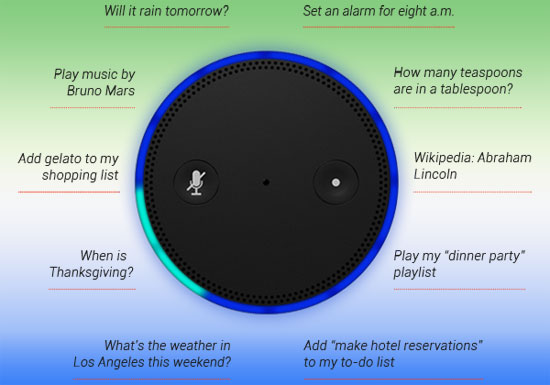Amazon on Thursday announced Echo, a speaker with a built-in voice-activated personal digital assistant. Think of a cylindrical Bose SoundLink Mini married to Siri, Cortana or Google Voice — or heck, living in sin with all three.
Echo can conduct Web searches, add items to your to-do list, let you play streaming music, and give you news and weather reports, among other things.
It’s connected to the Amazon Web Services cloud, so it can learn on the fly. In fact, it keeps learning continuously.
Echo is always on and works on its own or with users’ mobile devices. A free app that runs on Android, Amazon’s Fire OS, and desktop and iOS browsers is available.
Echo is priced at US$199; Amazon Prime subscribers can get $100 off for a limited period.
Beg If You Want an Echo
However, purchasing one is not as simple as just getting on the Amazon site and plunking down your credit card number.
These devices are sold by invitation only, so prospective purchasers have to go to the Echo Web page and request an invitation.
If Amazon deigns to accept their money, it will send them an invitation to purchase within a few weeks.
What’s an Echo? Echo? Echo?
Echo is a black cylinder 9.25 inches long by 3.27 inches in diameter.
It has a 2.5-inch woofer and a 2-inch tweeter, a reflex port that enhances the woofer’s output for distortion-free rendition of tunes that are heavy on the bass, an action button, a microphone off button, a volume ring at the top end, and a light ring right on top.
An array of seven microphones — one in the center and the other six spaced out along the rim — is placed under the light ring. They use beam-forming technology to pick up sound from any direction, so all you have to do to turn Echo on is say the magic word: “Alexa.”
Why “Alexa”? No idea — and Amazon did not respond to our request for further details.
Enhanced noise cancellation means Echo can hear users’ questions or commands even while it is playing music.
Aural Issues
Echo has two speakers that face down to produce 360-degree omnidirectional audio.
It can play streaming music either on its own or using a Bluetooth connection from users’ smartphones and tablets.
Echo is WiFi-enabled.
Will Echo Make the Cut?
Like the Fire Phone, which failed miserably, Echo could push Amazon content and product sales.
“If you’re an Amazon Prime user, I could see how this device would be appealing for adding items to your shopping cart,” said Brian Blau, a research director at Gartner.
“Otherwise, as a remote speaker, it may not be too attractive, as there are many to choose from today,” he told the E-Commerce Times.
“The advantage of the Echo is, you don’t need to go to your phone or PC to make a purchase from Amazon,” Boris Metodiev, a research manager at 451 Research, told the E-Commerce Times. “The disadvantage is, this is another piece of hardware you need to buy; Google Now and Siri come with hardware you already have.”
True, most of Echo’s features are already available in smartphones, but “connected audio devices are very attractive to consumers,” said Eric Smith, an analyst at Strategy Analytics.
What About the Competition?
At $199, given its high sound quality, Echo is competitively priced, Smith told the E-Commerce Times.
The real issue now is the quality of the user experience. That’s where the Fire Phone failed, Smith said, because it “was just a shopping cart for your pocket with Adaptive 3D.”
Timing also may be an issue, Metodiev pointed out, because “there are so many alternatives out there that if the Echo isn’t perfect, it won’t succeed.”























































Social Media
See all Social Media